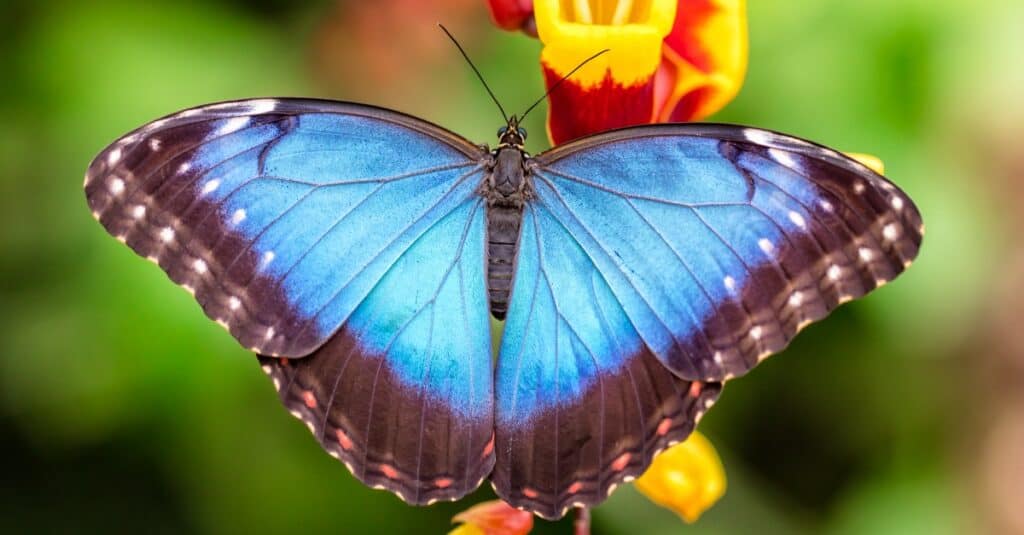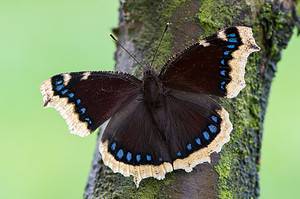If you’re interested in studying butterflies, you have over 1,100 species worldwide to choose from. Though butterflies look like delicate creatures, they are fast fliers and extremely adaptable animals. You’ve probably spent some time watching a butterfly making its way through a garden of flowers during the day.
But, when these fluttering creatures disappear at night, do you ever wonder where they go to sleep?
Read on to discover the answer to the question: Where do butterflies sleep?
Also, consider some of the specifics of how these insects rest and what they do when the winter season approaches.

©iStock.com/Binnerstam
Do Butterflies Go into a Deep Sleep?
A butterfly doesn’t sleep in the same way a human sleeps. In fact, if a butterfly were to go into a deep sleep, it would be putting itself in danger of being eaten by a predator. So, instead of sleeping, a butterfly becomes less active.
Butterflies don’t sleep, they can rest at night or during the day when the weather is rainy or cold. They will rest with their eyes open, typically hidden in foliage and will often hang upside down from leaves or sticks.
Scientists call it going into a state of quiescence. When it’s in a state of quiescence a butterfly is getting the rest it needs while avoiding the dangers of going into a deep sleep.
When Do Butterflies Sleep?
Butterflies are cold-blooded animals. This means they need the warmth of the sun to maintain a normal body temperature. Furthermore, they need warmth to have enough energy to move their wings and fly around looking for nectar and other sources of nourishment.
So, it stands to reason that butterflies rest at night when they don’t have the sunlight to keep them warm.
Where Do Butterflies Sleep?
Butterflies can sleep in many places in their habitat. Some of these insects crawl into a crevice between rocks while others sleep in a dense bush or even in a hanging plant on the porch of a home.
The main thing a butterfly looks for when it wants to go to sleep is protection from predators that may pass by at night. They also want shelter from any rain that may fall during the night.
Where Do Butterflies Sleep in the Winter?
Since butterflies are cold-blooded, most adults can’t survive in the freezing temperatures that occur in the winter. This is why many adult butterflies migrate to warmer places when they sense the approach of cold weather. The monarch and the Painted Lady are two examples of butterflies that migrate to warmer climates. You may have heard about the monarch butterflies that flock to Mexico. But not all butterflies go elsewhere in the winter.
Butterflies that stay around in the winter are found in other forms. Butterfly eggs, larva (caterpillar), or pupa can survive the winter weather. For instance, a butterfly larva (also known as a caterpillar) can burrow into the ground under a pile of leaves in the winter. It goes into a dormant state until the spring season arrives. Butterfly eggs and pupa are also designed to withstand the wintry conditions of a temperate climate.
Are There Any Adult Butterflies That Can Survive Cold Winter Weather?
Yes. An adult Mourning Cloak butterfly is able to spend the winter in a temperate climate. These butterflies sometimes slip beneath the bark of a tree or into a narrow space inside a log. The adult butterfly goes into a dormant stage and survives the cold weather in this type of shelter.

©iStock.com/Delbars
Do Butterflies Ever Overwinter in Houses?
Yes, some adult butterflies spend the winter in people’s houses. It seems hard to believe but this is true. Two butterflies namely the small tortoiseshell and the Peacock butterfly have a reputation for seeking shelter in people’s homes in the winter.
These butterflies find their way into a home in late summer. The cool, dry environment of a home is attractive to them. A crevice in a wall or a dark corner would be an appealing place for an adult butterfly to hide.
The problem comes when the furnace goes on inside a home in the winter. These butterflies sense the increase in temperature and come out of their dormant state. They are fooled into thinking that spring has arrived. However, it’s still snowing and much too cold outside for them to survive so a homeowner can’t let them outdoors.
Scientists recommend that a homeowner gently put the butterfly in a box and set the box in a cool room in the home. This change in temperature may send the butterfly back into a dormant state. The butterfly should be kept in that cooler room until spring arrives and warmer temperatures return. Then, the butterfly should be given a way to go outside when it’s ready.
Do Butterflies Sleep in Groups or Alone?
Both. Some types of butterflies sleep or rest in groups while others remain alone. The butterflies that sleep in groups have an advantage over the solitary ones.
A group of butterflies may gather in bushes or hang upside down beneath the leaves in a large collection of plants. By staying close together, they can create warmth between them which is essential for a butterfly’s survival. Secondly, sleeping in a group of butterflies provides a simple, yet effective method of protection against predators.
Normally, butterflies rest or sleep with their wings folded upward. If one butterfly in the group detects a predator or another threat nearby, it unfolds its wings. Its opened wings touch the butterfly right next to it causing that butterfly to unfold its own wings. This simple movement allows a warning signal to quickly travel through a group of butterflies so they can escape to a better resting place.
Butterflies need all of the protection they can get from predators considering these insects are near the bottom of the food chain.
What Position Does a Butterfly Sleep In?

©Jag_cz/Shutterstock.com
Generally, butterflies rest by hanging upside down from a twig or stem. If they are inside a thick bush, they may simply fold their wings and become very still. The blue morpho butterfly folds its wings when at rest just like other butterflies. But, it has a built-in advantage many other butterflies don’t have.
The blue morpho butterfly lives in the tropical forests of South America. It is best known for its iridescent blue wings featuring a black border dotted with white spots. But, when it folds its wings, it reveals a brown underside with a pattern that looks like a line of eyes.
These eyes may fool a predator into thinking it’s pursuing an animal that is staring right at it! So, when a blue morpho folds its wings at night, it has protection in the form of wing camouflage. Of course, this camouflage is useful during the day as well.
When morning comes, butterflies spread their wings to warm them in the sunlight. Once this insect’s body temperature goes up, the butterfly can move around during the day.
What Are Some Misconceptions About Butterflies and Their Resting Behavior?
As mentioned above, monarch butterflies migrate to the warmer climate of Mexico in the wintertime. There is a common misconception regarding a monarch butterfly’s trip to Mexico.
Though one generation of monarch butterflies travels down to Mexico for the winter, it’s another generation that returns to the temperate climate in the spring. Five generations of monarch butterflies are involved in this migration pattern.
Another misconception about butterflies is they have eyelids that close in order to get rest. In truth, butterflies don’t have eyelids.
Some people think butterflies only sleep at night. This is incorrect. A butterfly may rest during the day for various reasons. The approach of a thunderstorm is one reason. A large drop of rain can knock a butterfly out of the air.
This is dangerous because a butterfly on the ground is at great risk of being attacked by a predator. Also, a butterfly’s wings can be damaged by raindrops. So, a butterfly will seek shelter beneath a leaf or in a bush as soon as the wind picks up. It’ll rest there until the winds and rain have passed.
If a butterfly becomes too hot during the day, it may take some time to rest. It chooses a place beneath a leaf to cool itself a bit before going back out to continue its search for food.
What to Do If You Find a Butterfly Resting at Night?
Butterflies are experts at finding great hiding places where they can rest at night. So, it’s rare to stumble upon a butterfly when it’s dark. But, it happens from time to time.
The best thing to do is to put some distance between you and the insect to avoid disturbing it into flight. If a butterfly is disturbed at night and tries to fly away it is in danger of ending up on the ground. Leaving the butterfly at peace in its hiding place is the wisest course of action.
Next Up…
- Butterfly Predators: What Eats Butterfly? – What animals eat butterflies? Keep reading to find out!
- Are Monarch Butterflies Poisonous? – Should you avoid monarch butterflies? Click here to learn all about them!
- Do Butterflies Bite? – Do butterflies have teeth, or can they sting you? Read on to find out if butterflies are harmless!
The photo featured at the top of this post is © iStock.com/Gabi Uhrova
Thank you for reading! Have some feedback for us? Contact the AZ Animals editorial team.






